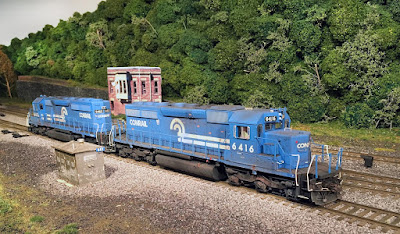Layout building is an amalgamation of so many projects, large and small. After about 10 full years of construction, associated design changes and then operations, I have reached a point where it's hard sometimes to appreciate the some of the smaller projects and details, since I spend so much time thinking and considering the whole thing.
Thankfully, I'm not alone - this railroad and the operating atmosphere it supports is the product so far of many talented guys (and patient women). One the regular yard engineers, Joe R., commented on how much he was enjoying operating Conrail GP38 #7714. It's an Atlas mechanism, well-maintained but otherwise stock. The decoder is a Soundtraxx Tsunami2, and to it I added the SoundTraxx Current-Keeper capacitor to bridge any dirty track.
Seeing as though we are on the Albany Division here, while GP38's are great, it's the GE B23-7's that really hold the fort down at most yards. So, learning from what I'd heard from Joe, I proceeded on a small project: adding a capacitor to B23-7 #1931, an Atlas unit I'd detailed, renumbered and weathered. These work alright, but on my isolated frogs with adjacent turnouts, we did have the occasional stall or hiccup, shutting the sound and lights down momentarily and detracting from realism.
1931 has an ESU-LocSound V4 decoder, so I used their 'Power Pack' capacitor board. The installation is fairly simple and requires a little bit of soldering to the board, and then mounting the capacitor somewhere out of the way inside the shell.
After the most recent session, the crew spoke highly of #1931 - no stalls, just nice smooth operations. So, just the addition of a little capacitor circuit made a difference in one of the most critical jobs.
When we can listen and make small changes to accommodate constructive criticism, I feel we make the hobby more fun for others. That helps them want to come back. Is there a greater service we can do for the hobby? Maybe, but sometimes it's the little things that count.
~RGDave



















































